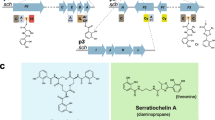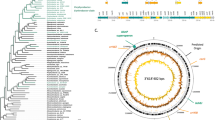Abstract
Production of bioluminescence theoretically represents a cost, energetic or otherwise, that could slow Vibrio fischeri growth; however, bioluminescence is also thought to enable full symbiotic colonization of the Euprymna scolopes light organ by V. fischeri. Previous tests of these models have proven inconclusive, partly because they compared nonisogenic strains, or undefined and/or pleiotropic mutants. To test the influence of the bioluminescence-producing lux operon on growth and symbiotic competence, we generated dark ∆luxCDABEG mutants in strains MJ1 and ES114 without disrupting the luxR-luxI regulatory circuit. The MJ1 ∆luxCDABEG mutant out-competed its visibly luminescent parent ~26% per generation in a carbon-limited chemostat. Similarly, induction of luminescence in the otherwise dim ES114 strain slowed growth relative to ΔluxCDABEG mutants. Some culture conditions yielded no detectable effect of luminescence on growth, indicating that luminescence is not always growth limiting; however, luminescence was never found to confer an advantage in culture. In contrast to this conditional disadvantage of lux expression, ES114 achieved ~fourfold higher populations than its ∆luxCDABEG mutant in the light organ of E. scolopes. These results demonstrate that induction of luxCDABEG can slow V. fischeri growth under certain culture conditions and is a positive symbiotic colonization factor.







Similar content being viewed by others
References
Björkman J, Hughes D, Andersson DI (1998) Virulence of antibiotic-resistant Salmonella typhimurium. Proc Natl Acad Sci USA 31:3949–3953
Blanc-Potard A, Gari E, Spirito F, Figueroa-Bossi N, Bossi L (1995) RNA polymerase (rpoB) mutants selected for increased resistance to gyrase inhibitors in Salmonella typhimurium. Mol Gen Genet 247:680–692
Boettcher KJ, Ruby EG (1990) Depressed light emission by symbiotic Vibrio fischeri of the sepiolid squid Euprymna scolopes. J Bacteriol 172:3701–3706
Boettcher KJ, Ruby EG (1995) Detection and Quantifiction of Vibrio fischeri autoinducer from symbiotic squid light organs. J Bacteriol 177:1053–1058
Bose JL et al (2007) Bioluminescence in Vibrio fischeri is controlled by the redox-responsive regulator ArcA. Mol Microbiol 65:538–553
Bourgois J-J, Sluse FE, Baguet F, Mallefet J (2001) Kinetics of light emission and oxygen consumption by bioluminescent bacteria. J Bioeng Biomembr 33:353–363
Boylan M, Miyamoto C, Wall L, Grahm A, Meighen E (1989) LuxC, D, and E genes of the Vibrio fischeri luminescence operon code for the reductase, transferase, and synthetase enzymes involved in aldehyde biosyntheses. Photochem Photobiol 49:681–688
Callahan SM, Dunlap PV (2000) LuxR- and acyl-homoserine-lactone-controlled non-lux genes define a quorum sensing regulon in Vibrio fischeri. J Bacteriol 182:2811–2822
Czyz A, Plata K, Wegrzyn G (2003) Stimulation of DNA repair as an evolutionary drive for bacterial bioluminescence. Luminescence 18:140–144
Czyz A, Wrobel B, Wegrzyn G (2000) Vibrio harveyi bioluminescence plays a role in stimulation of DNA repair. Microbiol 146:283–288
Davidson SK, Koropatnick TA, Kossmehl R, Sycuro L, McFall-Ngai MJ (2004) NO means “yes” in the squid-vibrio symbiosis: nitric oxide (NO) during the initial stages of a beneficial association. Cellular Microbiology 6:1139–1151
Diederich L, Roth A, Messer W (1994) A versatile plasmid vector system for the regulated expression of genes in Escherichia coli. Biotechniques 16:916–923
Duane W, Hastings JW (1975) Flavin mononucleotide reductase of luminous bacteria. Mol Cell Biochem 6:53–64
Dunlap PV, Kita-Tsukamoto K, Waterbury JB, Callahan SM (1995) Isolation and characterization of a visibly luminous variant of Vibrio fischeri strain ES114 from the sepiolid squid Euprymna scolopes. Arch Microbiol 164:194–202
Dunn AK, Martin MO, Stabb EV (2005) Characterization of pES213, a small mobilizable plasmid from Vibrio fischeri. Plasmid 54:114–134
Dunn AK, Millikan DS, Adin DM, Bose JL, Stabb EV (2006) New rfp- and pES213-derived tools for analyzing symbiotic Vibrio fischeri reveal patterns of infection and lux expression in situ. Appl Environ Microbiol 72:802–810
Eberhard A (1972) Inhibition and activation of bacterial luciferase synthesis. J Bacteriol 109:1101–1105
Engebrecht J, Nealson K, Silverman M (1983) Bacterial bioluminescence: isolation and genetic analysis of functions from Vibrio fischeri. Cell 32:773–781
Fidopiastis PM, Miyamoto C, Jobling MG, Meighen EA, Ruby EG (2002) LitR, a new transcriptional activator in Vibrio fischeri, regulates luminescence and symbiotic light organ colonization. Mol Microbiol 45:131–143
Fuqua WC, Winans SC, Greenberg EP (1994) Quorum sensing in bacteria: the LuxR-LuxI family of cell density-responsive transcriptional regulators. J Bacteriol 176:269–275
Graf J, Dunlap PV, Ruby EG (1994) Effect of transposon-induced motility mutations on colonization of the host light organ by Vibrio fischeri. J Bacteriol 176:6986–6991
Gray KM, Greenberg EP (1992a) Physical and functional maps of the luminescence gene cluster in an autoinducer-deficient Vibrio fischeri strain isolated from a squid light organ. J Bacteriol 174:4384–4390
Gray KM, Greenberg EP (1992b) Sequencing and analysis of luxR and luxI, the luminescence regulatory genes from the squid light organ symbiont Vibrio fischeri ES114. Mol Mar Biol Biotechnol 1:414–419
Harvey EN (1952) Bioluminescence. Academic Press, New York
Hastings JW, Nealson KH (1977) Bacterial bioluminescence. Annu Rev Microbiol 31:549–595
Holms WH, Hamilton ID, Robertson AG (1972) The rate of turnover of the adenosine triphosphate pool of Escherichia coli growing aerobically in simple defined media. Arch Mikrobiol 83:95–109
Hussa EA, O’Shea TM, Darnell CL, Ruby EG, Visick KV (2007) Two-component response regulators of Vibrio fischeri: Identification, mutagenesis, and characterization. J Bacteriol 189:5825–5838
Jin DJ, Gross CA (1989) Characterization of the pleiotropic phenotypes of rifampin-resistant rpoB mutants of Escherichia coli. J Bacteriol 171:5229–5231
Karl D, Nealson KH (1980) Regulation of cellular metabolism during synthesis and expression of the luminous system in Beneckea and Photobacterium. J Gen Microbiol 117:357–368
Keynan A, Hastings JW (1961) The isolation and characterization of dark mutants of luminous bacteria. Biol Bull 121:375
Kozakiewicz J, Gajewska M, Lyzen R, Czyz A, Wegrzyn G (2005) Bioluminescence-mediated stimulation of photoreactivation in bacteria. FEMS Microbiol Lett 250:105–110
Lanzer M, Bujard H (1988) Promoters largely determine the efficiency of repressor action. Proc Natl Acad Sci USA 85:8973–8977
Lee K-H, Ruby EG (1994) Competition between Vibrio fischeri strains during initiation and maintenance of a light organ symbiosis. J Bacteriol 176:1985–1991
Lei B, Liu M, Huang S, Tu S-C (1994) Vibrio harveyi NADPH-flavin oxidoreductase: cloning, sequencing and overexpression of the gene and purification and characterization of the cloned enzyme. J Bacteriol 176:3552–3558
Lin JW, Chao YF, Weng SF (1998) Characteristic analysis of the luxG gene encoding the probable flavin reductase that resides in the lux operon of Photobacterium leiognathi. Biochem Biophys Res Commun 246:446–452
Lupp C, Hancock RE, Ruby EG (2002) The Vibrio fischeri sapABCDF locus is required for normal growth, both in culture and in symbiosis. Arch Microbiol 179:57–65
Makemson JC (1986) Luciferase-dependent oxygen consumption by bioluminescent Vibrios. J Bacteriol 165:461–466
Makemson JC, Hastings JW (1986) Luciferase-dependent growth of cytochrome-deficient Vibrio harveyi. FEMS Microbiol Ecol 38:79–85
McCann J, Stabb EV, Millikan DS, Ruby EG (2003) Population dynamics of Vibrio fischeri during infection of Euprymna scolopes. Appl Environ Microbiol 69:5928–5934
Meighen EA (1994) Genetics of bacterial bioluminescence. Annu Rev Genet 28:117–139
Miller JH (1992) A short course in bacterial genetics. Cold Spring Harbor Laboratory Press, New York
Millikan DS, Ruby EG (2004) Vibrio fischeri flagellin A is essential for normal motility and for symbiotic competence during initial squid light organ colonization. J Bacteriol 186:4315–4325
Neidhardt FC, Ingraham JL, Schaechter M (1990) Physiology of the bacterial cell: a molecular approach. Sinauer Associates, Inc., Sunderland
Nelson EJ, Tunsjo HS, Fidopiastis PM, Sorum H, Ruby EG (2007) A novel lux operon in the cryptically bioluminescent fish pathogen Vibrio salmonicida is associated with virulence. Appl Environ Microbiol 73:1825–1833
Peterson C, Moller LB (2000) Invariance of the nucleoside triphosphate pools of Escherichia coli with growth rate. J Biol Chem 275:3931–3935
Pooley DT et al (2004) Continuous culture of photobacterium. Biosens Bioelectron 19:1457–1463
Rosson RA, Nealson KH (1981) Autoinduction of bacterial bioluminescence in a carbon limited chemostat. Arch Microbiol 129:299–304
Ruby EG, Asato LM (1993) Growth and flagellation of Vibrio fischeri during initiation of the sepiolid squid light organ symbiosis. Arch Microbiol 159:160–167
Ruby EG, Nealson KH (1976) Symbiotic association of Photobacterium fischeri with the marine luminous fish Monocentris japonica: A model of symbiosis based on bacterial studies. Biol Bull 151:574–586
Ruby EG, Nealson KH (1977) Pyruvate production and excretion by the luminous marine bacteria. Appl Environ Microbiol 34:164–169
Stabb EV (2005) Shedding light on the bioluminescence “paradox”. ASM News 71:223–229
Stabb EV (2006) The Vibrio fischeri-Euprymna scolopes light organ symbiosis. In: Thompson FL, Austin B, Swings J (eds) The biology of vibrios. ASM Press, Washington, D.C., pp 204–218
Stabb EV, Butler MS, Adin DM (2004) Correlation between osmolarity and luminescence of symbiotic Vibrio fischeri strain ES114. J Bacteriol 186:2906–2908
Stabb EV, Ruby EG (2002) RP4-based plasmids for conjugation between Escherichia coli and members of the Vibrionaceae. Methods Enzymol 358:413–426
Stabb EV, Ruby EG (2003) Contribution of pilA to competitive colonization of Euprymna scolopes by Vibrio fischeri. Appl Environ Microbiol 69:820–826
Tu S-C, Mager HIX (1995) Biochemistry of bacterial bioluminescence. Photochem Photobiol 62:615–624
Visick KG, Ruby EG (1996) Construction and symbiotic competence of a luxA-deletion mutant of Vibrio fischeri. Gene 175:89–94
Visick KL, Foster J, Doino J, McFall-Ngai M, Ruby EG (2000) Vibrio fischeri lux genes play an important role in colonization and development of the host light organ. J Bacteriol 182:4578–4586
Walker EL, Bose JL, Stabb EV (2006) Photolyase confers resistance to UV light but does not contribute to the symbiotic benefit of bioluminescence in Vibrio fischeri ES114. Appl Environ Microbiol 72:6600–6606
Watanabe H, Hastings JW (1982) Specificities and properties of three reduced pyridine nucleotide-flavin mononucleiotide reductases coupling to bacterial luciferase. Mol Cell Biochem 44:181–187
Wei SL, Young RE (1989) Development of symbiotic bacterial bioluminescence in a nearshore cephalopod, Euprymna scolopes. Mar Biol 103:541–546
Weis VM, Small AL, McFall-Ngai MJ (1996) A peroxidase related to the mammalian antimicrobial protein myeloperoxidase in the Euprymna-Vibrio mutualism. Proc Natl Acad Sci USA 93:13683–13688
Yanofsky C, Horn V (1981) Rifampicin resistance mutations that alter the efficiency of transcription termination at the tryptophan operon attenuator. J Bacteriol 145:1334–1341
Zenno S, Saigo K (1994) Identification of the genes encoding NAD(P) H-flavin oxidoreductases that are similar in sequence to Escherichia coli Fre in four species of luminous bacteria: Photorhabdus luminescens, Vibrio fischeri, Vibrio harveyi, and Vibrio orientalis. J Bacteriol 176:3544–3551
Ziegler MM, Baldwin TO (1981) Biochemistry of bacterial bioluminescence. In: Current topics in bioenergetics. Academic Press, Inc., Chestnut Hill, pp 65–113
Acknowledgments
We thank Melissa Butler, Alecia Septer, Deanna Colton, Anne Dunn, Dawn Adin, and Noreen Lyell for technical assistance, and Karen Visick for sharing strains. Genome information was provided by the Vibrio fischeri Genome Project, at http://ergo.integratedgenomics.com/Genomes/VFI, supported by the W. M. Keck Foundation. This work was supported by a CAREER award to EVS from the National Science Foundation (MCB-0347317), by National Institutes of Health grant R01AI50661, and by a STIR grant from the Army Research Office (49549LSII).
Author information
Authors and Affiliations
Corresponding author
Additional information
Communicated by Andreas Brune.
Rights and permissions
About this article
Cite this article
Bose, J.L., Rosenberg, C.S. & Stabb, E.V. Effects of luxCDABEG induction in Vibrio fischeri: enhancement of symbiotic colonization and conditional attenuation of growth in culture. Arch Microbiol 190, 169–183 (2008). https://doi.org/10.1007/s00203-008-0387-1
Received:
Revised:
Accepted:
Published:
Issue Date:
DOI: https://doi.org/10.1007/s00203-008-0387-1




